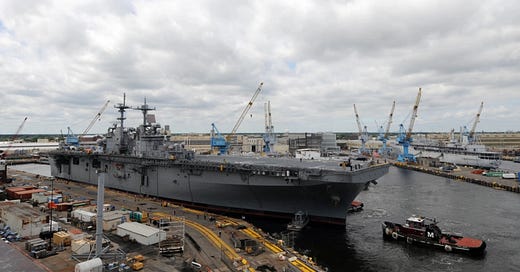This did not happen overnight, and it will not be fixed overnight. This is a problem thirty years in the making, from Perry’s Last Supper through all the programmatic grabassery of the Age of Transformationalism, to today’s inability of our senior leaders to beat this drum first above all others.
Behold the harvest from the Cult of Efficiency via AP’s David Sharp at NavyTimes:
The labor shortage is one of myriad challenges that have led to backlogs in ship production and maintenance at a time when the Navy faces expanding global threats. Combined with shifting defense priorities, last-minute design changes and cost overruns, it has put the U.S. behind China in the number of ships at its disposal — and the gap is widening.
Navy shipbuilding is currently in “a terrible state” — the worst in a quarter century, says Eric Labs, a longtime naval analyst at the Congressional Budget Office.
“I feel alarmed,” he said. “I don’t see a fast, easy way to get out of this problem. It’s taken us a long time to get into it.”
Marinette Marine is under contract to build six guided-missile frigates — the Navy’s newest surface warships — with options to build four more. But it only has enough workers to produce one frigate a year, according to Labs.
In spite of our bitter harvest in 2024, we still have the same legal structure, programs, procedures, mindset, and in many cases the same people in charge today who created this complete self-own:
Much of the blame for U.S. shipbuilding’s current woes lies with the Navy, which frequently changes requirements, requests upgrades and tweaks designs after shipbuilders have begun construction.
That’s seen in cost overruns, technological challenges and delays in the Navy’s newest aircraft carrier, the USS Ford; the spiking of a gun system for a stealth destroyer program after its rocket-assisted projectiles became too costly; and the early retirement of some of the Navy’s lightly armored littoral combat ships, which were prone to breaking down.
The Navy vowed to learn from those past lessons with the new frigates they are building at Marinette Marine. The frigates are prized because they’re less costly to produce than larger destroyers but have similar weapon systems.
The Navy chose a ship design already in use by navies in France and Italy instead of starting from scratch. The idea was that 15% of the vessel would be updated to meet U.S. Navy specifications, while 85% would remain unchanged, reducing costs and speeding construction.
Instead, the opposite happened: The Navy redesigned 85% of the ship, resulting in cost increases and construction delays, said Bryan Clark, an analyst at the Washington-based think tank Hudson Institute. Construction of the first-in-class Constellation warship, which began in August 2022, is now three years behind schedule, with delivery pushed back to 2029.
The final design still isn’t completed.
We still have not identified the core cause of our problem.
“The Navy’s role in defending our nation and promoting peace has never been more expansive or mattered more,” said Lt. Kyle Hanton, a spokesperson for Del Toro’s office. “We continue to work with our industry partners to identify creative solutions to solving our common challenges.”
This is a lesser included mission of what has yet to be done—and it has to be done by Congress. We have an ineffective kludge of a system with patches over patches, burdened by an aggregate of adhesions, duct tape, and bailing wire.
Money alone will not help. Three things need to be done:
Replace Goldwater-Nichols.
Force a root-and-branch restructuring of our acquisition system, specifically ripping out those “Joint” adhesions that add nothing but time, delay, cost, and ineffectiveness.
Reimagine COCOMs.
That will take either an existential crisis, or superior leadership—perhaps both.
It will also take time. As a patch, we need to find more money to build the maritime and aerospace power that we need to meet the challenge west of the International Date Line.
If we cannot grow DOD’s budget overall, then we need to break the allocation pies to align with maximizing our comparative advantages. That is going after the pie of the service that will have the least requirement in Pacific War with the People’s Republic of China: The US Army.





“Reimagine COCOMs.”
This. This must happen before the ending of jointness or as I like to call it “jointmess”.
For the love of God why can’t we build a simple vessel with the space to build out future capabilities but stick to the damn plan!!?
- 5 inch
- Bow mounted best available sonar/insutu ASW
- flight deck for 2 MH-60R
- multi use VLS (12 tubes still better than none)
- SPY / AESA radar suite
- fleet NWC common digital communications
- towed array
Then stop. Let the tech come to the fleet for future block builds. This ain’t hard.
Sal,
Army guy here but not why I disagree. I disagree with your priorities.
1. Fix the Navy acquisition mindset first
2. take on DOD constraints
3. prove you can get more bang for the buck.
4. Then and only then do you deserve more money
giving you Army money now will just feed your addiction and reduce your need to reform.